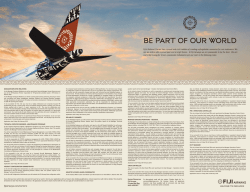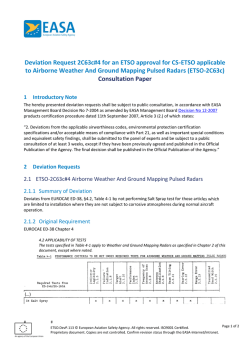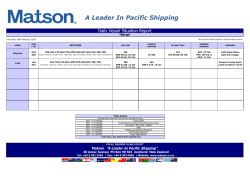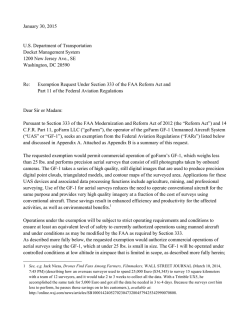
Home_files/SAA Auckland Chapter Newsletter Jan 2015
The newsletter of the Sport Aircraft Association (Auckland Chapter) Inc Sport Aviator January 2015 www.saaauckland.org.nz Committee 2014 Contents EXECUTIVE COMMITTEE President: Vice President: Secretary: Treasurer: Evan Wheeler 09 238 6081 027 924 807 Warren Sly 09 534 2364 021 266 0585 09 576 3676 4 From the Editor 5 Chapter News 19 Mystery Aircraft Quiz 20 In The News & On The Web 23 Upcoming Events COMMITTEE MEMBERS David CampbellMorrison 09 817 4782 Presidents Report 18 Team RV at Masterton 09 534 2364 021 266 0585 Peter Armstrong 3 16 Round the World Visitor Gordon Sanders Don Wilkinson 09 576 5009 Committee 2014 14 An Unusual Arrangement Gavin Magill 09 298 7174 027 291 0525 Nev Hay 09 521 7077 2 Next Meeting WHEN: Thursday 29th Jan 2015 WHERE: Auckland Society of Model Engineers Club Rooms Peterson Road, Panmure Basin Mt Wellington OPERATIONAL POSITIONS Safety Officer Norm Bartlett 09 528 0108 Technical Library Sandy Wilson 09 536 4018 Tool Library Manfred Scherbius 09 298 0221 021 081 365 03 Newsletter Editor Gavin Magill 027 291 0525 Catering Carl Pudney 027 430 5303 Airspace Users Group Steve Chilcott 09 625 5273 SPEAKER: TBA. TECHNICAL MENTORS Wood & Fabric Mike Tunnicliffe 09 237 8173 Composites Alistair McLachlan 299 2775 Metal Skin Kevin Paulsen 296 5125 Avionics Liviu Filimon 268 1199 FRONT PAGE Team RV line up at Hood Aerodrome for their Wings Over Wairarapa aerobatics display on the airshow practice day, Friday 16th Jan. Left To Right. Stephen Jones (ZK-NVS), Kevin Paulsen (ZK-PRV), Des Barry (ZK-DES) and David Wilkinson (ZK-WLK) SAANZ Auckland Sport Aviator January 2015 3 President’s Report Hi Everyone The festive season is now behind us with the days growing shorter and the leaves on the liquid amber starting to change colour already. We have certainly had one of the best holiday period weather patterns for many years. I trust many an hour has been spent drilling holes in the sky by those who have been able to get out and about. I spent a week before Xmas rectifying some cracking of fuselage frames on my drag brace strut of the under carriage. Under the skilful direction of Alastair McLachlan we made up new doublers and installed these really strengthening up this area of the airframe. The original design could certainly be improved on without much effort and eliminate this potential for a collapsed landing gear as has occurred a number of times in the USA. So with this issue resolved it was back in the air and enjoy however the ignition system decided better and started to run rough. Having just completed the 500 hour slick magneto I thought this to be where the problem lay. A check of the wiring harness on a test rig found a pinhole in an ignition lead and subsequent no spark occasionally. $690 later and problem solved, so now getting ready for the biannual sojourn to the South Island and Great plains Fly In via Healthy bastards flying competitions at Omaka (to watch only). Have just finished meeting with CAA policy staff in Wellington in support of a NZSAA submission from Bruce Cooke regarding compliance costs in the initial certification of newly built aircraft. We expect to be advised of further progress within the next month. Had a quick visit to Te Papa to check out the Air NZ 75th anniversary exhibition currently on. I found that museums are not just a place where old fossils and things are displayed when I came upon a photo and brief article regarding Nev Hay which I have forwarded on for Gavin to include in this month’s newsletter. That’s it from me and hope to see you at the Great Plains, Ashburton Waitangi weekend. Cheers Evan SAANZ Auckland Sport Aviator January 2015 4 From The Editor As an organisation we owe these guys a huge vote of thanks for their commitment to the cause. David commented to me just prior to the weekend that he had accumulated over 15 hours of practice in the two weeks leading up to the event. Well done guys. Hi Everyone Happy belated New Year. Hopefully you all enjoyed your break and those of you building have made progress on your projects while those flying have gotten out and about. I have managed to get to a couple of events over the break and have seen members at both so can only assume most have. It should also be noted that the Wairarapa Amateur Aircraft Builders club was also out in force with a great ground display as well. It has already been a very eventful summer with a number of incidents occurring round the country in the last month or so. Sadly the most recent was a fatal accident outside of Timaru however the rest have thankfully just resulted in bent or submerged airframes. I am sure everyone in the Chapter was greatly relieved to hear that Auckland Chapter members Kevin Paulsen and Alan Butler and Kevin’s wife Leanne all managed to escape their watery landing at Raglan. <Steps onto soapbox> Alan and Kevin’s emergency was probably a very timely reminder that EFATO is a very real threat to all of us who fly for recreation and we should all be regularly practising our emergency drills for this situation. I know I am guilty of not practising these skills anywhere near as often as I should be. So it may be time to set aside a flight or two just to practice these skills. It is also probably wouldn’t hurt to ask an instructor along to brush up your skills as well. <Steps off soapbox> One of the events I have managed to get to during January was the Wings Over Wairarapa Airshow at Masterton. I took the easy option and let a Jetstar pilot fly me to Wellington and then drove over to Masterton. The weather mostly cooperated however the gusty winds over the weekend did sadly make it too risky for the WWI aircraft to fly. That said, SAANZ was represented in very fine form by Team RV with Kevin Paulsen, David Wilkinson, Les Barry and Steven Jones performing an excellent four ship aerobatic routine which wowed the crowds. SAANZ Auckland The next big event on the SAA calendar is of course the Great Plains Fly-In at Ashburton. If you are intending to go and haven’t yet registered then please register with the Ashburton Aviation Museum using the registration form which is available on the SAANZ website under the Events page. The mystery aircraft in the November newsletter was not guessed by anyone so I think Barry Gillingwater earns the chocky fish for coming up with an aircraft which could not be identified. The aircraft in question was in fact a Tupolev SB2 Katyushka from WWII. This month’s mystery aircraft is provided by Steve Stride. Steve is a colleague of Don Wilkinson who is based in the UK and gets sent our newsletter by Don each month. He thought we might like to have a go at identifying the aircraft in the image he sent through. Have a go and send me your answer by email. I hope you enjoy the newsletter and I will likely see you on Thursday evening at the Model Engineers Clubrooms. Cheers Gavin Sport Aviator January 2015 5 Chapter News P R O J E C T U P D A T E P R O J E C T Ken Watters – Vans RV-7 U P D A T E Gary Briggs – Sonex #1531 By Ken Watters By Gary Briggs Hi Gavin, It’s starting to look like a plane at last. I have fitted all the tail feathers and taken them off again mainly for easier access to the top skins for riveting but also to reduce the size and weight for getting the plane out the first floor window one of these days. The rear top skins are now almost complete and I will be moving on to the cabin now to do the floors and side panels. Regards, Ken. Happy New Year to all I hope all had a good break, my progress has been a bit slow in the last few weeks. I have now completed the "Aft spar carry through" and it is now time to fit the wings, and pick up the holes in the fuselage. For the Sonex builders this can be a very frustrating exercise, but I am tackling this task a bit differently. I have final drilled the main spar mount holes to 3/8" before the wings were assembled where the plans require a 1/4" pilot hole. I have made a 3/8" bush with a 1/4" ID hole to guide the 1/4" pilot drill, then take it out to 3/8" Cheers Gary SAANZ Auckland Sport Aviator January 2015 6 Chapter News P R O J E C T N E W S Alistair’s Levitation Machine By Gordon Sanders The Project Alistair McLachlan’s latest means of levitation is rather different from most member’s projects but there are similarities. Like an aircraft it has a prop, aerodynamic control surfaces, important C of G limits, and relies on a combination of lift and thrust for performance. It is one of a range of similar vehicles designed by aerospace engineer Barry Palmer, who designed and flew one of the first powered trikes in 1967 and followed on with improved models, then Florida style air boats and surface effect vehicles or skimmers, commonly known as hovercraft. The Sevtec Surveyor can be built as either a 14ft or 16ft long version, both being 7ft wide when the skirt is deflated, and as a single or twin engine model. Alistair has chosen the 14ft single engine version and, at the designer’s recommendation, is building it ‘to the plans’ not modifying a proven design. That can be done later if desired after experience is gained. It is constructed of urethane foam sheets glued together and fibreglassed inside and out using polyester resin. This creates a strong hull with considerable reserve buoyancy. Wood blocks are included only where hard points are required for attachments. Power is provided by a 25~28hp vertical shaft motor as used in ride-on lawnmowers. While the originals used either B&S Vanguard or Kohler motors Alistair is using a locally purchased 25hp after-market replacement one. The lift fan attaches directly to the motor drive shaft while power to the thrust prop is provided by a Vbelt routed over pulleys, as clearly seen in the photos. The white nylon blocks that the belt passes through prevent the long runs flapping. Obtaining a suitable muffler was a problem as little or nothing suitable is available ‘off the shelf’ with the correct pipe diameter. However a local manufacturer came to the party with good results. The steel frame supporting the engine, propeller and associated components is just SAANZ Auckland regular mild steel given a good anticorrosive paint job. Similarly the frame for the prop guard is mild steel tube, nothing fancy, just practical, as is everything about the craft. The first engine runs were successfully completed earlier this month and finishing tasks, including tidying up the wiring, are under way. Completion is scheduled for Saturday – just deciding which one. Motor, lift fan and prop drive Background Some time back Alistair and I, with input from DCM and Alfred, were exploring the idea of building hovercraft as build projects and an interesting way of exploring this country’s vast selection of interesting coastal and inland waterways. Similar to choosing which aircraft to build, the first step was to define the mission or missions, then see how well different makes and models matched up. We wanted to be able to carry a minimum of two people, plus camping and other equipment, with a good degree of safety in a range of weather conditions. We found that a number of the smaller hovercraft were roughly the equivalent of jet skis. Over powered and go like stink, OK for racing but of little practical use. Sport Aviator January 2015 7 Chapter News P R O J E C T N E W S Alistair’s Levitation Machine – Cont By Gordon Sanders They also often used Rotax engines, making them expensive to build and operate. WIG (Wing In Ground-effect) vehicles aroused initial interest but were discarded as potentially being fun but unsuitable for mission. Other craft had poor rough water performance, often contributed to by front mounted lift fans. The Sevtec hovercraft models could be likened to range of small to medium launches with proven performance in open water, including a 1,400 mile trip from Washington State to Alaska in the 20ft Explorer and a 460 mile trip over the big waters of Puget Sound in a 16hp 12½ ft Vanguard. Unfortunately the Sevtec craft are not the sexiest looking ones, but reliable performance trumps looks any day. Top speed is adequate. While it naturally varies with engine power, load carried, and surface being traversed (smooth ice is the fastest, uneven ground or very rough water the slowest) Alistair’s Surveyor should achieve better than 50kph over smooth water, lightly loaded. As with selecting an aircraft, cost of owning and operating had to be considered. The majority of materials for construction of the Sevtec range can be purchased locally, including the required density and thickness (or nearest metric equivalent) of urethane foam from Forman Insulation. Special parts, and even complete kits, are available from the USA at reasonable prices. A suitable transport trailer can be locally manufactured. Alistair is investigating the use of a modified jet ski one. Being trailerable also minimises storage costs, just take it home and put a cover over it. A lawn mower motor of 25~30hp is a lot cheaper to buy, run and maintain than a Rotax or similar motor and, being a marine craft, regulatory compliance costs are minimal to non-existent for both craft and operator. There is plenty of info on the web relating to building and operating Sevtec craft. Just Google ‘Sevtec Hovercraft’ or something similar and follow your nose. SAANZ Auckland The Surveyor in its temporary home Lastly, the reason Alistair is nearly ready to launch while I have yet to start building mine is mainly that I am not allowing myself to start until I have completed the major renovations to my house and, being retired, I am doing all the finishing work myself, and there’s a lot of it. Still, nearly there and I’ll get that Code Compliance Certificate signed off yet! M E M B E R U P D A T E Kevin Paulsen - Team RV Leader By David Wilkinson Sport Aviator January 2015 8 Chapter News P R O J E C T U P D A T E David Grove Hills – Vans RV-4 By David Grove Hills Work on the RV4 over the last year has been steady if not meteoric. I shoot myself in the foot by not being here. Three months away from home is not conducive to finishing a project such as this in record time. Although not aviation related I have to mention that part of that three months was a trip to the Isle of Man motorcycle TT with 65,000 other petrol heads and while there witnessed the superbike lap record being taken out by New Zealander Bruce Anstey, average speed 132.298 mph (212.913 km/h). On country roads! Yes these guys are insane. Good to see that he was recognised in the 2015 New Year's Honours List. After uprighting the fuselage, work started on the rear turtledeck which proved to be ill-fitting. Frustratingly the only way to address the problem was to remove the pre-bent webs on two of the bulkheads, and rivet on replacements, a suggestion made in Van's construction manual should difficulties arise, not me being OTT. David Wilkinson's timely intervention pointed me in the direction of a part used on the RV8 which has saved many hours of fabrication. Vertical and horizontal stabilisers are 90% complete and fitted. No real problems, except the area where HS front spar meets fuselage. There are some half dozen angle pieces and spacers to be made and one particular aluminium angle that bolts to the fuselage longerons is fairly critical in that it is difficult to maintain specified hole to edge distances. I am happy with the Mk3 version! HS front spar/fuselage attach area Just started canopy frame fitting. The blogs have proved very helpful in this area. Suggested mod to ill-fitting bulkheads. SAANZ Auckland Start of canopy frame fit. Sport Aviator January 2015 9 Chapter News P R O J E C T U P D A T E P R O J E C T David Grove Hills – Vans RV-4 Cont. Peter McVinnie – Glastar ZK-OPM Instead of mating the front canopy frame to the instrument panel as per manual, it's a lot easier to mate the instrument panel to the frame. If I had the skills and composite knowledge would probably replace the aluminium frame skins with glass as many do, although there could be a weight penalty. RV8 Instrument panel attach flanges being fitted to RV 4 bulkheads Hopefully the next couple of months will see the fuselage standing on its own two feet as it were and the first and penultimate wing fit." M E M B E R U P D A T E Three generations of Wilkinson’s Joining overhead at Springhill. David had James in the back. SAANZ Auckland U P D A T E By Peter McVinnie Hi Gavin, OPM is flying, and has its Special Category Amateur Built Airworthiness Certificate, issued by CAA at 1630 on Christmas Eve! I am delighted with its docile characteristics and performance! I flew her to Matamata yesterday (18 Jan) to see how the Walsh Memorial Flying School was going. 72 students and 25 instructors there this year, and all is going very well with the amazing spell of weather they have had. About half the ab-initio students have soloed so far. Next year is the 50th anniversary of this wonderful institution, and they are planning a big reunion. I was on school #4 in 1970 it is quite different now with ATC controlling the movements on the three parallel 10/28 runways with ALPHA holding points, and even has ATIS! It was all uncontrolled in my day, with a lot of NORDO ops. It was great to mingle with students and instructors, and see how much fun and enthusiasm there is amongst everyone. Regards, Peter McVinnie PS. OPM was N90PM in the States. I couldn't organise the painter to remove the N9 whilst reassembling the aircraft, so put a Kiwi patch over it to leave OPM - I'm starting to like it! Sport Aviator January 2015 10 Chapter News P R O J E C T U P D A T E M E M B E R U P D A T E Nev Hay in Te Papa Collection Nev Hay – Pearce Replica By Nev Hay (Pictures by Ian Allen) By Evan Wheeler Hi all Some pics of ZK RPT at Masterton Wings over Wairarapa 17 Jan 2015 by Ian Allen. I estimate I got to 15-18mph (cross wind from the left at about 10kts. Temp 29c) and was ‘blipping’ the engine so I did not go faster. The wing was fully ‘inflated’ so was getting good lift and the elevator and aileron/spoiler were effective. Did not go faster as I did not know where the C-of-G was. Lady running alongside starboard wing is Ivan’s Mudrovcich’s D-in-L and could not keep up – so it was moving well. Nev Hi Gavin Dropped into Te Papa to kill a few hours after CAA meeting. The 75th Anniversary display of Air NZ was on and I came across this photo. I always thought a museum was a storeroom of old fossils and things. Can’t say that about Nev though. Subject: Pearce Replica From: David Wilkinson This weekend Dad and I went to Warbirds over Wairarapa. Very good family friend Nev Hay (well known NZ aviation personality) was doing high speed runs in this replica of the Pearse replica. The real engine is on display at the Air NZ exhibition. Dad says it was in the back cupboard of his class while he was doing his training! SAANZ Auckland Sport Aviator January 2015 11 Chapter News R N Z A F These skills were built upon, when they continued to learn in larger, more complex aircraft, he said. N E W S Red Checker Bid Final Goodbye By Thomas Heaton Beaton said it was sad to see the "capable little planes" go, as the Airtrainers gave the RNZAF's pilots their first taste of military flying. The Red Checkers fly in formation for their finale over Ohakea Air Force Base, celebrating 16 years’ service. The planes were also used for aerobatics by the Red Checkers team, who performed around the country. As the new planes take centre stage, the CT-4E fleet will return to the outfit from which they were being leased, Pacific Aerospace. The new aircraft boasted bigger engines, so could go a lot higher and a lot further, and the cockpit configuration had changed, Beaton said. The Royal New Zealand Air Force's Red Checkers have had their swansong. Seven of the 11 new T-6C aircraft have been received already; the remaining four aircraft are expected to arrive mid-2015. The air force's 13 CT-4E Airtrainers had a final farewell as they flew over Manawatu yesterday. The Airtrainers are being replaced by a new fleet of 11 Beechcraft T-6C Texan IIs, which were purchased this year. Families, former pilots and RNZAF members watched five of the aircraft fly over Ohakea Air Force Base, commemorating 16 years of service. They were expected to be used for the 2016 wings course. A competition is being run to rename the Red Checkers, to better suit the new aircraft, through the air force's Facebook page. Officer commanding the pilot training school, Squadron Leader Ben Stephens, led the farewell flyover. "It was important to recognise the contribution of the aircraft and share the experience with the pilot training school team." About 190 students learnt to fly the planes and successfully passed through the Airtrainer phase of their "wings course". Commanding officer of flight training Wing Commander Richard Beaton said the planes had seen 72,000 flying hours since 1998. "They have been the training platform for our pilots to learn day and night flying, navigation, instrument and formation flying." SAANZ Auckland Sport Aviator January 2015 12 Chapter News I N By Jenny Davies M E M O R I U M Ian Paul Davies By Don Wilkinson Ian Paul Davis 31 July 1938 - 26 November 2014 The Late Ian Davies was a very active SAA Member during the time of Pikes Point Airfield. He not only built a Bobcat microlight and half a Quickie Q2 but he and his wife Jenny were very active in the affairs of Pikes and the AK chapter at the time. Both were good to be with and really involved in many interests in their busy lives. Ian epitomised the word "innovator". Adventurous, hard-working and resourceful, he was predominately a motorcycle buff from his early years and a fan of the Bert Munro story. Ian was on the MCC Community board for Mangere Bridge and as such proved to be a challenging critic of Mayor Sir Barry Curtis. Ian told numerous funny stories of confrontation with The Mayor, always with a gleeful laugh when telling. He was a mechanical engineer with a very practical view point on many subjects. He was with a bunch of mates, all on motor bikes, heading for Invercargill for the Bert Munro commemoration, something they did each year, when an apparent sudden heart attack stopped him south of Queenstown. He died before he hit an oncoming van. More than a dozen of his flying friends attended his funeral along with many dozens of his motorcycle mates and the families of his two sons. Ian's final departure was with the accompanying roar of some 20 or 30 motor bike engines. He would have been laughing. A terribly sad and sudden loss for many of us but particularly for Jenny, with whom he was deeply in love. Jenny presented the attached reading at Ian's Funeral with emotion, courage and dignity. SAANZ Auckland When God put Ian on this earth he gave him 76 years. “Ian”, he said “you need that much time because you are also going to have three wives and this will distract you from some of the tasks ahead. The bonus is you will start your family young but you will also have to work long hard hours to support them. You will have already developed a passion for motorbikes and speed so it will be a bit of a juggling act to keep everybody happy but you will love your children unconditionally and do all you can to give them a great childhood and you will invent many things so they can have much fun. You will build them bikes and trolleys (often from others waste), take them camping, hiking, sailing, fishing and motorcycling and instil in them the principles you live by”. ‘Also’, said God, I am giving you an inquiring and inventive mind which will see you take on many tasks, this will leave you with a total inability to shop (unless it’s to get a bag of nuts or a tin of sardines), prepare or cook food, clean the house or do the washing!!! –well that’s why you will have three wives. Sport Aviator January 2015 13 Chapter News The last of these will be your greatest love, your best friend, your everything but be careful not to take her for granted. She will be your greatest supporter as you will be hers, your business manager and companion. She be your Accountant and your Doctor figuring how to keep the finances afloat and your health in good shape. I will find you many people who share your intelligence, whacky sense of humour and with whom you will be able to bounce ideas back and forth. You will treasure these friends and some will be like extra sons to you with whom you can share your passion for flying and for motorbikes. Yes Ian, you will take up flying and enjoy the freedom of the sky and the challenge of building an aircraft, but because that takes time first you’ll find a couple of like-minded mates and buy one already built. You will always enjoy the challenge and stimulation of making things work and finding a “Low Tech” way of doing things. You will not know the time of your passing so you will have to pack in as much as you can and there will always be another invention in the tank. You will have a total irreverence for Authority, Government Departments, Rules and Regulations and you will try to sort out Councils and put them on the right track. You will always march to your own beat and your aim will be to leave the world a better place for your having been there. Your passing will come as a total shock to all who love you as they will not be expecting it but they will feel in some ways relieved that you were having the best of times and you went fast (just as you wanted). Rest Home Proprietors will all be breathing a great sigh of relief as you would’ve been organizing an uprising in no time at all to improve conditions, facilities etc. I am saving you the indignity of old age, infirmities and confinement. While no new memories will be made you will become a legend and stories will be told about your deeds and misdeeds for many years to come. You will watch over those you love and cherish and guide your projects from the afterlife and they in turn will keep you safe in their hearts and memories and think of you every day of their lives. SAANZ Auckland Sport Aviator January 2015 14 An Unusual Arrangement by Jon Farmer An Unusual Arrangement of Engine, Propeller and Airframe By Jon Farmer A few months ago, I was faced with a 5 hour wait on Hong Kong airport and spent the first half hour trying to find Virgin Pacific's check in counter. Why did it take so long? Well firstly, I guess I missed the board that gave the row number of each airline and I seem to remember there were some 12 rows. In each row there were perhaps 16 airlines and I dragged my wheelie suitcase up and down 7 rows before finding Virgin's check in desk. Once there, my suitcase was booked through to Auckland and I was issued with a boarding pass. Relieved of my burden I was free to look around and became so fascinated with a circus nearby that I found a seat to watch. A party of about 7 West Africans had been on a buying spree in Hong Kong and divided up the loot between them to suit the luggage allowances. One man had a coil of rope suitable to anchor a fair sized fishing vessel, another man was trying to pass off two car tyres as personal luggage and a third man took his television set out of its carton to avoid being oversize. With some four hours to kill, I wandered out onto an airbridge that connected the upper level departure hall with a high level road outside. Hanging there was what had seemed to be a model of the Wright Brothers aircraft but such was the massive size of the Arrival and Departure Hall that this was an optical illusion and the aircraft turned out to be a full size replica of a Bristol Boxkite. SAANZ Auckland The Bristol Boxkite replica hanging in the massive arrival/departure hall of Hong Kong airport to commemorate the first flight to be made there in 1911. Note the cabinets at the bottom of each pillar on the far wall. Each cabinet is around 20ft high and contains an air-conditioning unit. A bit of research indicated that the Bristol Boxkite was a very successful aircraft in its day as nearly 80 were built. Part of that success was due to the pronounced camber of the wing, more than most other aircraft of the time. Another reason was that the Bristol Aeroplane Company ran at least three flying schools in England, the philosophy being that the more people who could fly, the more aircraft would be sold. A number of governments bought Bristol Boxkites, notably, Russia, India, South Africa and even Australia bought two, one of which made several firsts. The test pilot took his wife for a flight and she became the first woman to fly in Australia. He also took a news reporter for a flight over Sydney who took the first aerial photographs in Australia. Sport Aviator January 2015 15 An Unusual Arrangement by Jon Farmer Nearly all the Bristol Boxkites were powered by 50hp Gnome rotary engines which were quite advanced being light, powerful and reliable. The crankshaft is stationary whilst the crankcase, cylinders and propeller all rotate round it. This solves the cooling problem as the cylinders are being whirled through the air, even on the ground, but it does also cause some problems. The carburettor has to be stationary on the airframe and the air/fuel mixture, along with lubricating oil, fed through the hollow crankshaft to the crankcase. Each cylinder has a pipe from the inlet poppet valve to the crankcase and the exhaust valve is operated by a push rod. Ignition is by an uninsulated wire from the sparkplug to a segment on a disc that rotates with the engine and is fed by a spark coil and brush gear attached to the airframe. Both rotary and radial engines have to have an odd number of cylinders although the connecting rod arrangement is different. In a rotary engine all the big ends go on the crank throw but in the radial engine, only the master rod goes to the crank and the other rods go to bearings at the big end of the master rod. The Bristol Boxkite first flew in 1910, about 7 years after Richard Pearse, and was still in use at the beginning of the First World War. However it was then superseded by the rapid advances in aerial technology. There are no original Boxkites left but a number of replicas, three of which are in flying condition although not with Gnome engines. The Australian Airforce Museum has a replica which first flew with an 0-200 engine hidden in a wooden box it now sports an Australian made Rotec radial engine. An original photograph of a Bristol Biplane, commonly called a 'Bristol Boxkite', which clearly shows the unusual position of the propeller between the engine and fuselage. Also of interest is the pronounced camber of the wings which contributed to the success of this aircraft over its competitors. The ailerons are held up by airflow in flight and are pulled downwards by movement of the joystick. Presumably the smaller of the two cylindrical tanks contains castor oil for the total loss lubrication system. Is there another aircraft in the World that has its propeller fitted between the engine and airframe? Think of the overhang on the crankshaft and it's hollow at that. What about the size of the hole in the prop hub? And with 7 cylinders, at least one is sure to be blanked off from the airflow by a prop blade. How about sending in your explanation and you might win a chocolate fish! Auckland Chapter has a spare one left over from last month's ' Name the mystery aircraft' competition which was not won. (It turned out to be a Russian bomber in German colours!). With an empty weight of 900lbs and MAUW of 1150lbs the Bristol Boxkite would fit into our microlight category but I'm not sure how they managed to carry a passenger and the small payload explains why all the early reports were of short flights, 15 minutes or less. The standard wingspan was 34 ½ feet but the military version had an upper wing 12 feet longer. Maximum speed of both versions was 40 mph. SAANZ Auckland Sport Aviator January 2015 16 Round the World Visitor Round the World Homebuilt Visits New Zealand By Bruce Cooke Shortly before dark on the evening of 10th January, a small, sleek homebuilt joined overhead Hamilton Airport and set down on runway 18. The aircraft was an extensively modified Lancair IV, with the American registration N6ZQ, and the sole occupant was its builder, Bill Harrelson of Kinston, North Carolina USA. The Lancair was at Hamilton as part of a record attempt for a circumnavigation crossing both North and South Poles, and as with ventures of this type, things hadn’t gone entirely to plan. The flight is an attempt to beat the existing FAI class C1A (landplane) record that was set by a Piper Malibu in 1987. The record is based on the total elapsed time between leaving the start point and arriving back at the start point having crossed both poles and landed at specifically nominated locations. The nominated locations are important. The flight could be done without nominating any, but the distance credit (which is used to calculate the speed) will then be based on the minimum great circle distance flown – nominally the diameter of the planet. By nominating points the great circle distances between those points get credited, which, chosen carefully should allow for practical deviations from the direct route. The trick is still to get around as quickly as possible but extra distances flown should at least be partly factored in. The Speed to beat in this instance isn’t particularly high, since the Malibu took 4 months, which gave an average speed to beat of 14km/h! SAANZ Auckland by Bruce Cooke Bill’s original plan was to fly from Kinston USA to Montevideo Uruguay, Punta Arenas, Chile, Over the South Pole to Hamilton NZ, then Honolulu Hawaii, Fairbanks Alaska, and finally over the North pole and back to Kinston. Montevideo, Hamilton and Fairbanks were the nominated points for the record. The flight through South America was largely to plan and on 2nd January Bill set off from Punta Arenas towards the South Pole. By the time he reached the pole however, it was apparent the headwinds he was experiencing were stronger than expected, and he would be marginal for fuel to reach New Zealand. Achieving the South Pole waypoint, he reluctantly returned to Punta Arenas. Reaching Hamilton took the best part of the next week, as Radio and autopilot issues had to be sorted, plus alternative plans for the leg to Hamilton. He did not need to risk the dangers of the polar flight again, so opted on a trans-pacific route via Papeete, French Polynesia. It took some time for appropriate approvals and confirmation of fuel availability but he was on his way again. The Papeete to Hamilton leg was also changed due to the difficulty in getting customs clearances in Hamilton, so a brief stopover in Auckland was required – in the event he was on the ground there for less than 30 minutes! Thankfully everything went to plan and Bill is now back on the original route. N6ZQ is the second Lancair that Bill has built, his first being Lancair 360 N5ZQ. Bill is an extremely studious person with a love of the challenge of a long distance flight. The Lancair IV was therefore built with long range flight in mind. Sport Aviator January 2015 17 Round the World Visitor The airbrakes in the wing were omitted to allow increased fuel capacity, and the normal rear seats were replaced with additional tanks, making it a 2 seater. For this flight even the second seat has gone, with additional cabin tanks have been fitted to bring the total fuel capacity up to over 1400 Litres – enough for 40 hours in the air. The Continental IO-550 has a larger sump and some mild performance modifications fitted. The aircraft is equipped with a comprehensive Avionics suite with multiple GPS units and 3 SpiderTracks tracking systems. An oxygen system is included, as is a special heater for the Polar Regions. by Bruce Cooke Bill has previously flown the Lancair from Guam to Florida non-stop – over 7500NM and 38 hrs in the air! He is obviously an adventurer with a vision to achieve a goal, but he is also a genuinely friendly homebuilder full of enthusiasm for flying. He regretted missing out on seeing much of New Zealand as he would have with his original route from the south, but enjoyed the scenery from the short transit from Auckland. Hopefully he will return again sometime to spend more time with us. We wish him well on the remainder of the adventure – safe travels! Everything is stowed neatly in the cabin to provide an efficient workflow, but in the tiny space left, even the most comfortable seat would start to feel tiring with 30hr+ legs! There is an autopilot, but when the aircraft is full of fuel, it has significant stability issues, so Bill has to hand fly it for the first 10hrs or so before it is safe to use. Bill says at its heavy weights, it is not a nice machine to fly. SAANZ Auckland Sport Aviator January 2015 18 Team RV At Masterton A few shots of the Team RV display at Wings Over Wairarapa at Masterton. Kevin Paulsen and Stephen Jones launch David’s solo display Followed by David Wilkinson… Des’s solo display. Showing off for the crowd afterwards. Then Des Barry. Heading back to the aircraft park. Line astern flypast. SAANZ Auckland Sport Aviator January 2015 19 Mystery Aircraft Quiz by Steve Stride A test for all those plane spotters out there. Identify the mystery aircraft in the picture below and email your answer to the editor at [email protected] before the next Chapter meeting and the first person to correctly identify the aircraft will earn themselves a chocolate fish prize. Note you will need to turn up to the meeting to collect your prize. SAANZ Auckland Sport Aviator January 2015 20 In The News & On The Web O N T H E W E B O N Airbus Formation T H E W E B The Beast of Turin From Huib Volker From Barry Gillingwater The echelon break to starboard looks amazing. I know it’s a car instead of an aeroplane but it’s an awesome engine just the same – maybe you think it might be suitable for the chapter newsletter? Watch this 28.5 litre Fiat run for the first time in over 100 years! https://grrc.goodwood.com/race/histori c/28-5-litre-fiat-s76-runs-first-time100-years http://www.chonday.com/Videos/fivebuj awe2 O N T H E W E B Air NZ Safety Video From Norm Bartlett Now this is one airline safety-video that is NOT boring. Enjoy. Must have cost a fortune. Think I will fly Air NZ just to watch the safety video. www.youtube.com/embed/qOw44VFNk8 Y?feature=player_embedded"framebord er="0"allowfullscreen></iframe O N T H E W E B CAMS Engineering From Nev Hay If you are interested in manufacturing it will take you some time to ‘wander’ through this site. Well worth a look http://www.youtube.com/embed/qOw4 4VFNk8Y?feature=player_embedded%2 2frameborder=%220%22allowfullscreen %3e%3c/iframe SAANZ Auckland http://www.cams.net.nz/ Sport Aviator January 2015 21 In The News & On The Web O N T H E W E B O N Watch an IPad land an aircraft T H E W E B Impressive Pitts Flying From Gavin Magill From Huib Volker Failed aircraft engine? Unconscious pilot? There’s an app for that! Check this out - very impressive Pitts flying: http://www.popsci.com/xavion-ipadapp-can-make-emergency-airplanelanding-autopilot http://vimeo.com/100670266 O N T H E W E B O N Mooney Emergency Landing W E B WWII Planes In A Barn From Peter Armstrong Mooney makes a textbook emergency landing with a failed front undercarriage. https://www.youtube.com/watch?v=ol4 rj5CWSP4#t=10 SAANZ Auckland T H E From Don Wilkinson WWII Planes in a barn. http://www.aopa.org/News-and-Video/AllNews/2014/August/Pilot/f_talltale Sport Aviator January 2015 22 In The News & On The Web I N T H E N E W S O N Solar Impulse T H E W E B Sukhoi PAK-FA From Rob Keith From Gavin Magill Gavin saw a reference to this in the newspaper. The A/C is now in Abu Dhabi. I think they start of the round the world flight sometime in March In the meantime how about a picture of one very lovely looking jet fighter. Rob K Sukhoi PAK-FA http://russianplanes.net/images/to1530 00/152437.jpg And a video to go with it. https://www.youtube.com/watch?v=h0 8AxiE2HwU O N T H E W E B Owning A Spitfire From Don Wilkinson Thought this might interest you. O N https://grrc.goodwood.com/coolstuff/youre-thinking-buying-spitfire T H E W E B Weather Map From Peter Armstrong Pass this on to your colleagues. Altitude and overlay selectable. https://www.windyty.com/?950h,wind,n ow,-33.395,-191.777,4 Cheers Peter SAANZ Auckland Sport Aviator January 2015 23 Jan 29 Upcoming Events Auckland Chapter Monthly Meeting Speakers: TBA Av i a t i o n C a l e n d a r 2015 Every Dargaville Aero Club Sat The place is buzzing every Sat, wet or fine, windy or calm, and the $12 lunch at 12.30 is good value. Club on the web at http://www.flyingnz.co.nz/club_pages/dar gaville.html. If going as a group please have the courtesy to ring in advance so the cook expects you. Contact Murray on 027-478 4308 or the club house on 09439 8024. Apr Classic Fighters Omaka Airshow 03-05 Omaka Airfield, Blenheim SAA Easter weekend. Friday is Practice Day, including the Marlborough Lines Twilight Extreme of sunset flying, concert and fireworks. Sat and Sun are the main airshow days with over 100 aircraft participating. Full info at: http://www.classicfighters.co.nz/ Jun Oshkosh, Wisconsin 2016 Mar Air Safari 2016 13-27 Starts at Omaka on 13th Mar, then via the scenic route (18 airfields) to finish at Alexandra on 27th Mar. If you need a leave pass signed it might be time to start working on the brownie points. A link to more info is on the SAANZ web site Events page at http://www.saa.org.nz/public_pages/events.ph p 3 Sun Turangi Aero Club Fly-In Each All welcome for a BBQ lunch. Month Contact Tony on 027-453 3740 Feb Great Plains Fly-In 2015 06-08 Ashburton Aviation Museum & Airfield Includes SAANZ AGM, Wings Award Dinner, etc. Further details to be confirmed. Download your info pack and registration form from the SAANZ web site http://www.saa.org.nz/public_pages/even ts.php. AirVenture (Oshkosh) 2015 20-26 rd Jan Healthy Bastards Bush Pilot Champs 06-08 Omaka Airfield, Blenheim More info and registration at www.marlboroughaeroclub.co.nz by Gordon Sanders If members are aware of other events that could be of interest to others please pass the details to Gordon Sanders - [email protected]. Feb 27 Australian International Airshow Mar 01 Avalon, Victoria Theme is Centenary of ANZAC, 1915~2015. Heroes of the Sky. Full information at: http://www.airshow.com.au/airshow2015/inde x.asp Mar National Aerobatic Championships 18-21 Hood Aerodrome, Masterton (Moved from Waipukurau). New venue with many facilities, both for flying and accommodation. Unofficial practice day Wed 17th. More info at http://www.aerobatics.co.nz/ SAANZ Auckland Sport Aviator January 2015
© Copyright 2026







